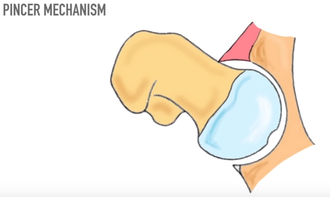Welcome back to the blog!!
Today we’re we’re moving up the chain from the knee to the hip. We’re discussing femoroacetabular impingement a.k.a. “hip impingement.” Anyone familiar with that “pinching” in the front of their hip with a squat, lunge, or while running has likely dealt with a “functional hip impingement” episode. If you have experienced this over a longer period of time, you should be evaluated for hip impingement syndrome.
Hip impingement has gained notice in the sports medicine community specifically over the last 15 years as advancements in diagnostics and surgical procedures has led to increased people going under the knife. This is a syndrome that can be defined in really 2 ways; intra-articular and extra-articular impingement. Extra-articular refers to soft tissue impingement outside the joint, which could be muscular or nervous system in nature. Most commonly though, we are refereing to intra-articular issues which are further classified in to 3 sub-diagnoses; a Pincer Lesion, Cam Lesion or Mixed Lesion. In a Pincer lesion the, there is bony overgrowth of the acetabular rim (the socket) that leads to decreased available motion for femoral head (ball) and increased “pinching” at the top of the joint with flexion. In a Cam Lesion, the overgrowth is on the neck of the femur and leads to an early contact between the acetabulum and head of the femur at end range. Both of these can lead to increased shearing at the joint. They are often diagnosed both clinically with certain special tests as well as with both x-ray and MRI. However, recent studies have show that clinical tests are not as specific as we would like them to be for diagnosis, and imaging does not seem to have a direct correlation between evidence of a Cam or Pincer lesion and the presence of pain.


The amount of information on the internet regarding this condition is endless. Also endless, is the amount of information on how to correct this condition. There are many options from many different medical practitioners including; massage, anti-inflammatory injection, surgery, stretching and strengthening, dry needling, myofascial release, adjusting squat position and form, etc… I’m here to tell you that you really should weigh your options and seek advice from a trusted health care professional to make a decision on your treatment. In many cases, non-operative treatment should be your absolute first choice.

A recent study (https://www.ncbi.nlm.nih.gov/pubmed/30398893) looking at FAI non-operative management in 76 youth athletes showed that 82% of athletes were successfully managed conservatively with rest, physical therapy, and progressive activity introduction.
This is obviously a study with youth, but much of the research also supports non-operative management in the older adult. Cam Impingement does seem to have a increased incidence of steroidal and surgical intervention.
Now, I’m not going to go over the specific exercises that will help you with hip impingement as you should be evaluated by a Physical Therapist to tailor a program directly to your needs or refer you for additional testing if needed, but I will say that structural findings on an imaging technique do not always correlate with pain. Many people function every day with structural hip Pincer and Cam lesions but are asymptomatic and able to squat heavy loads at the gym as well as run long distance races. Healthcare providers need to be very careful diagnosing people on imaging alone, and focus more on individual structural demands and goals for the patient.
Therefore, when looking for a solution to your “squat stopper” hip impingement problem, first seek medical advice from a trusted musculoskeletal expert. You should receive a detailed subjective and clinic evaluation that treats you as an individual with specific needs. Relay your goals to the clinician and then weigh your options based on multiple opinions on what your treatment should be. Remember, conservative treatment should be your first choice when addressing your pain and limitations. Most of the time, a skilled rehab specialist will be able to get you back to doing the things you love, with minimal to no pain all the while avoiding invasive techniques such as surgery if possible.
Well I hope this was educational for everyone. Make sure you check back in next week.
Thanks!
Dr. Luke




